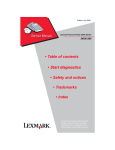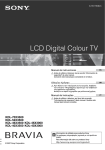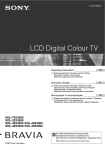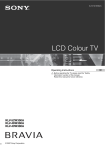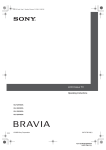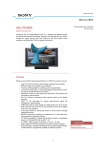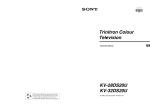Download Sony KDL-52X3500 User Guide Manual
Transcript
3-219-178-14(1) LCD Digital Colour TV Operating Instructions Before operating the TV, please read the “Safety information” section of this manual. Retain this manual for future reference. KDL-70X3500 KDL-52X3500 KDL-46X3500 KDL-46X3000 KDL-40X3500 KDL-40X3000 For useful information about Sony products © 2007 Sony Corporation Downloaded From TV-Manual.com Manuals Introduction Thank you for choosing this Sony product. Before operating the TV, please read this manual thoroughly and retain it for future reference. For KDL-70X3500 Users Refer to “KDL-70X3500 Start-up Guide” for details about the installation. The manufacturer of this product is Sony Corporation, 1-7-1 Konan Minato-ku Tokyo, 1080075 Japan. The Authorized Representative for EMC and product safety is Sony Deutschland GmbH, Hedelfinger Strasse 61, 70327 Stuttgart, Germany. For any service or guarantee matters please refer to the addresses given in separate service or guarantee documents. Notice for Digital TV function NOTICE FOR CUSTOMERS IN THE UNITED KINGDOM A moulded plug complying with BS1363 is fitted to this equipment for your safety and convenience. Should the fuse in the plug supplied need to be replaced with the same rating of fuse approved by ASTA or BSI to BS 1362 (i.e., marked with or ) must be used. When an alternative type of plug is used it should be fitted with the same rating of fuse, otherwise the circuit should be protected by a 13 AMP FUSE at the distribution board. If the plug supplied with this equipment has a detachable fuse cover, be sure to attach the fuse cover after you change the fuse. Never use the plug without the fuse cover. If you should lose the fuse cover, please contact your nearest Sony service station. • Any functions related to Digital TV ( ) will only work in countries or areas where DVB-T (MPEG2 and MPEG4 AVC) digital terrestrial signals are broadcast or where you have access to a compatible DVB-C (MPEG2 and MPEG4 AVC) cable service. Please confirm with your local dealer if you can receive a DVB-T signal where you live or ask your cable provider if their DVB-C cable service is suitable for integrated operation with this TV. • The cable provider may charge an additional fee for such services and you may be required to agree to their terms and conditions of business. • Although this TV set follows DVB-T and DVB-C specifications, compatibility with future DVB-T digital terrestrial and DVB-C digital cable broadcasts cannot be guaranteed. • Some Digital TV functions may not be available in some countries/regions and DVB-C cable may not operate correctly with some providers. For a list of compatible cable providers, refer to the support web site: http://support.sony-europe.com/TV/DVBC/ FUSE How to replace the fuse Open the fuse compartment with a blade screwdriver, and replace the fuse. Disposal of the TV set Disposal of Old Electrical & Electronic Equipment (Applicable in the European Union and other European countries with separate collection systems) This symbol on the product or on its packaging indicates that this product shall not be treated as household waste. Instead it shall be handed over to the applicable collection point for the recycling of electrical and electronic equipment. By ensuring this product is disposed of correctly, you will help prevent potential negative consequences for the environment and human health, which could otherwise be caused by inappropriate waste handling of this product. The recycling of materials will help to conserve natural resources. For more detailed information about recycling of this product, please contact your local Civic Office, your household waste disposal service or the shop where you purchased the product. Downloaded 2 GB From TV-Manual.com Manuals Trademark information • is a registered trademark of the DVB Project • HDMI, the HDMI logo and High-Definition Multimedia Interface are trademarks or registered trademarks of HDMI Licensing LLC. • Adobe is a registered trademark or a trademark of Adobe Systems Incorporated in the United States and/or other countries. • Manufactured under license from Dolby Laboratories. “Dolby” and the double-D symbol are trademarks of Dolby Laboratories. The illustrations used in this manual are of the KDL40X3500 unless otherwise stated. Table of Contents Start-up Guide 4 Safety information .....................................................................................................................9 Precautions .............................................................................................................................11 Overview of the remote ........................................................................................................12 Overview of the TV buttons and indicators ........................................................................14 Watching TV Watching TV............................................................................................................................15 Using the Digital Electronic Programme Guide (EPG) ....................................................17 Using the Digital Favourite list ........................................................................................19 Using Optional Equipment Connecting optional equipment...............................................................................................20 Viewing pictures from the connected equipment ....................................................................22 Using the remote.....................................................................................................................23 Using USB photo viewer .........................................................................................................26 Using HDMI control .................................................................................................................26 Using Menu Functions Navigating through menus ......................................................................................................27 Picture menu ...........................................................................................................................28 Sound menu............................................................................................................................30 Screen menu (except for PC input).........................................................................................32 Screen menu (for PC input) ....................................................................................................33 Video Settings menu ...............................................................................................................34 Audio Settings menu ...............................................................................................................36 Set-up menu............................................................................................................................37 Analogue Set-up menu ...........................................................................................................40 Digital Set-up menu ........................................................................................................43 Additional Information Specifications ..........................................................................................................................46 Cleaning ..................................................................................................................................48 Troubleshooting ......................................................................................................................48 : for digital channels only Downloaded From TV-Manual.com Manuals 3 GB Start-up Guide 1: Checking the accessories Mains lead (Type BF)* (1) 2: Attaching the stand (except for KDL70X3500/52X3500) Coaxial cable* (1) PC cable* (1) Support belt (1) and screws (2) Stand (1) and screws (4) (only for KDL-46X3500/ 40X3500/46X3000/40X3000) Remote RM-ED010 (1) Size AA batteries (R6 type) (2) * Do not remove the ferrite cores. To insert batteries into the remote Push and slide to open. ~ • Observe the correct polarity when inserting batteries. • Do not use different types of batteries together or mix old and new batteries. • Dispose of batteries in an environmentally friendly way. Certain regions may regulate the disposal of batteries. Please consult your local authority. • Handle the remote with care. Do not drop or step on it, or spill liquid of any kind onto it. • Do not place the remote in a location near a heat source, a place subject to direct sunlight, or a damp room. To replace the bezel unit (only for KDL-46X3000/40X3000) The bezel unit can be replaced with others that are sold separately. However, do not remove the unit except to replace it. For details, see the instructions supplied with bezel units. Downloaded 4 GB From TV-Manual.com Manuals 1 Place the TV onto the stand by aligning the screw hole alignment lines over the stand as shown. 2 Fix the TV to the stand using the supplied screws. ~ • This TV is very heavy, so two or more people should place the TV on the stand. • If using an electric screwdriver, set the tightening torque at approximately 1.5 N·m (15 kgf·cm). 4: Preventing the TV from toppling over Start-up Guide 3: Connecting an aerial/ cable/VCR Connecting an aerial/cable Coaxial cable (supplied) Mains lead (supplied) Terrestrial signal or cable Connecting an aerial/cable and VCR Mains lead (supplied) Coaxial cable (supplied) Terrestrial signal or cable Scart lead (not supplied) Coaxial cable (not supplied) VCR Downloaded From TV-Manual.com Manuals 5 GB 5: Bundling the cables 6: Performing the initial set-up ~ The hook of the cable holder can be opened from either sides depending on attaching position. 3, 4, 6, 7 3, 4, 6, 7 9 Selecting the language and country/ region 1 Connect the TV to your mains socket (220–240 V AC, 50 Hz). 2 Press 1 on the right side of the TV. When you turn on the TV for the first time, the Language menu appears on the screen. Downloaded 6 GB From TV-Manual.com Manuals 3 8 4 Press F/f to select the country/region in which you will operate the TV, then press . When the Programme Sorting menu appears on the screen, follow the steps of “Programme Sorting” on page 40. If you do not wish to change the order in which the analogue channels are stored on the TV, go to next step. 9 Press MENU to exit. The TV has now tuned in all the available channels. ~ When a digital broadcast channel cannot be received, or when selecting a country/region in which there are no digital broadcasts in step 4 (page 7), the time must be set after performing step 9. To tune the TV for digital cable connection If the country/region which you want to use on the TV does not appear in the list, select “–” instead of a country/region. 1 Press F/f to select “Scan Type”, then press . 2 Press F/f to select “Quick Scan” or “Full Scan”, then press . “Quick Scan”: Channels are tuned according to the cable provider’s information within the broadcast signal. The recommended setting for “Frequency”, “Network ID” and “Symbol Rate” is “Auto” unless your cable provider has supplied actual values to use. “Quick Scan” is recommended for fast tuning when this is supported by your cable provider. “Full Scan”: All available channels are tuned and stored. This procedure may take some time. This option is recommended when “Quick Scan” is not supported by your cable provider. For further information about supported cable providers, refer to the support web site: http://support.sony-europe.com/TV/DVBC/ Auto tuning the TV 5 Before you start auto tuning the TV, insert a pre-recorded tape into the VCR connected to the TV (page 5) and start play back. The video channel will be located and stored on the TV during auto tuning. If no VCR is connected to the TV, skip this step. 6 Press G/g to select “OK”, then press . 3 Press G/g/f to select “Start”, then press . The TV starts searching for channels. Do not press any buttons on the TV or remote. 7 Press F/f to select “Antenna” or “Cable”, then press . If you select “Cable”, the screen for selecting the scan type appears. See “To tune the TV for digital cable connection” on page 7. Downloaded From TV-Manual.com Manuals ~ Some cable providers do not support “Quick Scan”. If no channels are detected using “Quick Scan”, perform “Full Scan”. 7 GB Start-up Guide The TV starts searching for all available digital channels, followed by all available analogue channels. This may take some time, so do not press any buttons on the TV or remote while proceeding. If a message appears for you to confirm the aerial connection No digital or analogue channels were found. Check all the aerial connections and press to start auto tuning again. Press F/f/G/g to select the language displayed on the menu screens, then press . Detaching the TableTop Stand from the TV ~ Do not remove the Table-Top Stand for any reason other than to wall-mount the TV or to attach the optional TV stand. Downloaded 8 GB From TV-Manual.com Manuals Installed on the wall Safety information 30 cm 10 cm 10 cm Installation/Set-up Install and use the TV set in accordance with the instructions below in order to avoid any risk of fire, electrical shock or damage and/or injuries. 10 cm Leave at least this space around the set. Installation • The TV set should be installed near an easily accessible mains socket. • Place the TV set on a stable, level surface. • Only qualified service personnel should carry out wall installations. • For safety reasons, it is strongly recommended that you use Sony accessories, including: KDL-52X3500/46X3500/40X3500/46X3000/40X3000: – Wall-mount bracket SU-WL500 KDL-52X3500/46X3500/40X3500/46X3000/40X3000: – Floor stand SU-FL62 Transporting • Before transporting the TV set, disconnect all cables. • Two or three people are needed to transport a large TV set. • When transporting the TV set by hand, hold it as shown on the right. Do not put stress on the LCD panel and frame around the screen. • When lifting or moving the TV set, hold it firmly from the bottom. • When transporting the TV set, do not subject it to jolts or excessive vibration. except for KDL-52X3500 KDL-52X3500 • When transporting the TV set for repairs or when moving, pack it using the original carton and packing material. Ventilation • Never cover the ventilation holes or insert anything in the cabinet. • Leave space around the TV set as shown below. • It is strongly recommended that you use a Sony wallmount bracket in order to provide adequate air-circulation. Installed with stand 30 cm 10 cm 10 cm 6 cm Leave at least this space around the set. • To ensure proper ventilation and prevent the collection of dirt or dust: – Do not lay the TV set flat, install upside down, backwards, or sideways. – Do not place the TV set on a shelf, rug, bed or in a closet. – Do not cover the TV set with a cloth, such as curtains, or items such as newspapers, etc. – Do not install the TV set as shown below. Air circulation is blocked. Wall Wall Mains lead Handle the mains lead and socket as follows in order to avoid any risk of fire, electrical shock or damage and/or injuries: – Connect the TV set using a three-wire grounding type mains plug to a mains socket with a protective earthing connection. – Use only Sony mains leads, not those of other brands. – Insert the plug fully into the mains socket. – Operate the TV set on a 220–240 V AC supply only. – When wiring cables, be sure to unplug the mains lead for your safety and take care not to catch your feet on the cables. – Disconnect the mains lead from the mains socket before working on or moving the TV set. – Keep the mains lead away from heat sources. Continued Downloaded From TV-Manual.com Manuals 9 GB – Unplug the mains plug and clean it regularly. If the plug is covered with dust and it picks up moisture, its insulation may deteriorate, which could result in a fire. Notes • Do not use the supplied mains lead on any other equipment. • Do not pinch, bend, or twist the mains lead excessively. The core conductors may be exposed or broken. • Do not modify the mains lead. • Do not put anything heavy on the mains lead. • Do not pull on the mains lead itself when disconnecting the mains lead. • Do not connect too many appliances to the same mains socket. • Do not use a poor fitting mains socket. Prohibited Usage Do not install/use the TV set in locations, environments or situations such as those listed below, or the TV set may malfunction and cause a fire, electrical shock, damage and/or injuries. Location: Outdoors (in direct sunlight), at the seashore, on a ship or other vessel, inside a vehicle, in medical institutions, unstable locations, near water, rain, moisture or smoke. Environment: Places that are hot, humid, or excessively dusty; where insects may enter; where it might be exposed to mechanical vibration, near flammable objects (candles, etc). The TV set shall not be exposed to dripping or splashing and no objects filled with liquids, such as vases, shall be placed on the TV. Situation: Do not use when your hands are wet, with the cabinet removed, or with attachments not recommended by the manufacturer. Disconnect the TV set from mains socket and aerial during lightning storms. Broken pieces: • Do not throw anything at the TV set. The screen glass may break by the impact and cause serious injury. • If the surface of the TV set cracks, do not touch it until you have unplugged the mains lead. Otherwise electric shock may result. When not in use • If you will not be using the TV set for several days, the TV set should be disconnected from the mains for environmental and safety reasons. • As the TV set is not disconnected from the mains when the TV set is just turned off, pull the plug from the mains to disconnect the TV set completely. • However, some TV sets may have features that require the TV set to be left in standby to work correctly. The instructions in this manual will inform you if this applies. Downloaded 10 GB From TV-Manual.com Manuals For children • Do not allow children to climb on the TV set. • Keep small accessories out of the reach of children, so that they are not mistakenly swallowed. If the following problems occur... Turn off the TV set and unplug the mains lead immediately if any of the following problems occur. Ask your dealer or Sony service centre to have it checked by qualified service personnel. When: – Mains lead is damaged. – Poor fitting of mains socket. – TV set is damaged by being dropped, hit or having something thrown at it. – Any liquid or solid object falls through openings in the cabinet. Precautions Viewing the TV • View the TV in moderate light, as viewing the TV in poor light or during long period of time, strains your eyes. • When using headphones, adjust the volume so as to avoid excessive levels, as hearing damage may result. LCD Screen • Although the LCD screen is made with high-precision technology and 99.99% or more of the pixels are effective, black dots may appear or bright points of light (red, blue, or green) may appear constantly on the LCD screen. This is a structural property of the LCD screen and is not a malfunction. • Do not push or scratch the front filter, or place objects on top of this TV set. The image may be uneven or the LCD screen may be damaged. • If this TV set is used in a cold place, a smear may occur in the picture or the picture may become dark. This does not indicate a failure. These phenomena disappear as the temperature rises. • Ghosting may occur when still pictures are displayed continuously. It may disappear after a few moments. • The screen and cabinet get warm when this TV set is in use. This is not a malfunction. • The LCD screen contains a small amount of liquid crystal and mercury. The fluorescent tubes used in this TV set also contain mercury. Follow your local ordinances and regulations for disposal. Handling and cleaning the screen surface/cabinet of the TV set Be sure to unplug the mains lead connected to the TV set from mains socket before cleaning. To avoid material degradation or screen coating degradation, observe the following precautions. • To remove dust from the screen surface/cabinet, wipe gently with a soft cloth. If dust is persistent, wipe with a soft cloth slightly moistened with a diluted mild detergent solution. • Never use any type of abrasive pad, alkaline/acid cleaner, scouring powder, or volatile solvent, such as alcohol, benzene, thinner or insecticide. Using such materials or maintaining prolonged contact with rubber or vinyl materials may result in damage to the screen surface and cabinet material. • When adjusting the angle of the TV set, move it slowly so as to prevent the TV set from moving or slipping off from its table stand. Optional Equipment Keep optional components or any equipment emitting electromagnetic radiation away from the TV set. Otherwise picture distortion and/or noisy sound may occur. Downloaded From TV-Manual.com Manuals 11 GB Overview of the remote 1 TV "/1 — TV standby Turns the TV on and off from standby mode. 2 Number buttons • In TV mode: Selects channels. For channel numbers 10 and above, enter the second and third digit quickly. • In Text mode: Enters the page number to select the page. 3 — Previous channel Returns to the previous channel watched (for more than five seconds). 4 5 — Screen mode (page 16) — Picture freeze (page 15) Freezes the TV picture. 6 / — Input select / Text hold • In TV mode (page 22): Selects the input source from equipment connected to the TV sockets. • In Analogue Text mode (page 16): Holds the current page. 7 F/f/G/g/ (page 15, 27) 8 TOOLS (page 16, 22) Enables you to access various viewing options and change/make adjustments according to the source and screen format. 9 MENU (page 27) 0 PROG +/–/ / • In TV mode (page 15): Selects the next (+) or previous (–) channel. • In Analogue Text mode (page 16): Selects the next ( ) or previous ( page. ) qa % — Mute (page 15, 22) qs 2 +/– — Volume (page 22) qd THEATRE You can set Theatre Mode on or off. When Theatre Mode is set to on, the optimum audio output (if the TV is connected with an audio system using an HDMI cable) and picture quality for film-based contents are automatically set. z If you turn the TV off, Theatre Mode is also turned off. Downloaded 12 GB From TV-Manual.com Manuals qf RETURN / Returns to the previous screen of any displayed menu. qg — EPG (Digital Electronic Programme Guide) (page 17) qh Coloured buttons (page 16, 17, 19) qj DIGITAL/ANALOG — TV mode (page 15) qk A/B — Dual Sound (page 31) ql / — Text (page 15) w; LIGHT Illuminates the buttons on the remote so that you can see them easily even if the room is dark. wa / — Info / Text reveal • In digital mode: Displays brief details of the programme currently being watched. • In analogue mode: Displays information such as current channel number and screen format. • In Analogue Text mode (page 16): Reveals hidden information (e.g. answers to a quiz). ws Buttons for using optional equipment See page 23. z The number 5, H, PROG + and A/B buttons have tactile dots. Use the tactile dots as references when operating the TV. Downloaded From TV-Manual.com Manuals 13 GB Overview of the TV buttons and indicators 1 1 — Power Turns the TV on or off. ~ To disconnect the TV completely, pull the plug from the mains. PROG 2 PROG +/–/ / • In TV mode: Selects the next (+) or previous (–) channel. • In TV menu: Moves through the options up ( ) or down ( ). 3 2 +/–/ / • In TV mode: Increases (+) or decreases (–) the volume. • In TV menu: Moves through the options right ( ) or left ( ). MENU / 4 — Input select / OK • In TV mode (page 22): Selects the input source from equipment connected to the TV sockets. • In TV menu: Selects the menu or option, and confirms the setting. (page 27) 5 — Picture Off / Timer indicator 6 • Lights up in green when the picture is switched off (page 38). • Lights up in orange when the timer is set (page 37). 7 1 — Standby indicator Lights up in red when the TV is in standby mode. 8 " — Power / Timer REC programme indicator • Lights up in green when the TV is turned on. • Lights up in orange when the timer recording is set (page 17). • Lights up in red during the timer recording. 9 Remote control sensor / Light sensor (page 38) • Receives IR signals from the remote. • Do not put anything over the sensor, as its function may be affected. ~ Make sure that the TV is completely turned off before unplugging the mains lead. Unplugging the mains lead while the TV is turned on may cause the indicator to remain lit or may cause the TV to malfunction. Downloaded 14 GB From TV-Manual.com Manuals Watching TV Watching TV To select a digital channel using the Digital Electronic Programme Guide (EPG), see page 17. In digital mode An information banner appears briefly. The following icons may be indicated on the banner. HD service Interactive service is available (Digital Text) Radio service Scrambled/Subscription service Subtitles available Subtitles available for the hearing impaired : Multiple audio languages available : Recommended minimum age for current programme (from 4 to 18 years) : Parental Lock c (in red): Current programme is being recorded 1 3 Additional operations 2 To Press Freeze the picture (Picture freeze) . Press again to return to normal TV mode. ~ This function is not available for a PC input source. 3 1 Press 1 on the right side of the TV to turn on the TV. When the TV is in standby mode (the 1 (standby) indicator on the TV front panel is red), press TV "/1 on the remote to turn on the TV. 2 Press DIGITAL/ANALOG to switch between digital and analogue modes. The channels available vary depending on the mode. 3 Press the number buttons or PROG +/– to select a TV channel. To select channel numbers 10 and above using the number buttons, enter the second and third digits quickly. Downloaded From TV-Manual.com Manuals Access the Programme index table (in analogue mode only) . To select an analogue channel, press F/f, then press . Access the Digital Favourites (in digital mode only) . For details, see page 19. Mute the sound %. Press again to restore. Turn on the TV without sound from standby mode %. To access Digital Text Many broadcasters provide a Digital Text service. Digital Text offers graphically rich contents, compared to Analogue Text. Select a digital channel which provides Digital Text, then press /. When a broadcaster provides a dedicated Digital Text channel, select this channel to access Digital Text. To navigate through Digital Text, follow the instructions on the screen. Continued 15 GB Watching TV : : : : : : To exit Digital Text, press RETURN. To move around, press F/f/G/g. To select items, press and the number buttons. To access shortcuts, press the coloured buttons. 14:9* Displays 14:9 broadcasts in the correct proportions. As a result, black border areas are visible on the screen. To access Analogue Text In analogue mode, press /. Each time you press /, the display changes cyclically as follows: Text and TV picture t Text t No Text (exit the Text service) To select a page, press the number buttons or / . To hold a page, press / . To reveal hidden information, press / . * Parts of the top and bottom of the picture may be cut off. ~ Some characters and/or letters at the top and the bottom of the picture may not be visible in “Smart”. In such a case, you can select “Vertical Size” using the “Screen” menu and adjust vertical size to make it visible. z z • You can also jump directly to a page by selecting the page number displayed on the screen. Press and F/f/G/g to select the page number, then press . • When four coloured items appear at the bottom of the Text page, Fastext is available. Fastext allows you to access pages quickly and easily. Press the corresponding coloured button to access the page. To change the screen format manually to suit the broadcast Press repeatedly to select the desired screen format. Smart* Displays conventional 4:3 broadcasts with an imitation wide screen effect. The 4:3 picture is stretched to fill the screen. 4:3 Displays conventional 4:3 broadcasts (e.g. non-wide screen TV) in the correct proportions. Wide Displays wide screen (16:9) broadcasts in the correct proportions. Zoom* Displays cinemascopic (letter box format) broadcasts in the correct proportions. Downloaded 16 GB From TV-Manual.com Manuals • When “Auto Format” is set to “On”, the TV will automatically select the best mode to suit the broadcast (page 32). • You can adjust the position of the picture when selecting “Smart” (50Hz), “Zoom” or “14:9”. Press F/f to move up or down (e.g. to read subtitles). • Select “Smart” or “Zoom” to adjust for 720p, 1080i or 1080p source pictures with edge portions cut off. Using the Tools menu Press TOOLS to display the following options when viewing a TV programme. Options Description Close Closes the Tools menu. Picture Mode See page 28. Sound Mode See page 30. Motion Enhancer See page 34. Speaker See page 36. PAP See page 22. Audio Language (in digital mode only) See page 44. Subtitle Setting (in digital mode only) See page 43. Digital Favourites (in digital mode only) See page 19. i Volume See page 36. Sleep Timer See page 37. Power Saving See page 38. Auto Clock Set (in analogue mode only) Allows you to switch to digital mode and obtain the time. System Information (in Displays the system digital mode only) information screen. Using the Digital Electronic Programme Guide (EPG) * 1 2 In digital mode, press . Digital Electronic Programme Guide (EPG) * This function may not be available in some countries/regions. To Do this Watch a programme Press F/f/G/g to select the programme, then press Turn off the EPG Press Sort the programme information by category – Category list 1 Press the blue button. 2 Press F/f to select a category, then press Set a programme to be recorded – Timer REC 1 Press F/f/G/g to select the programme you want to record, then press / . 2 Press F/f to select “Timer REC”. 3 Press to set the TV and your VCR timers. . . . The categories available include: “All Categories”, “Radio”: Contains all available channels. Other category name (e.g. “News”): Contains all programmes corresponding to the selected category. A red c symbol appears by that programme’s information. The indicator on the TV front panel lights up in orange. z The above procedure can be used even if the programme to be recorded has already started. Set a programme to be displayed automatically on the screen when it starts – Reminder 1 Press F/f/G/g to select the future programme you want to display, then press / . 2 Press F/f to select “Reminder”, then press . A c symbol appears by that programme’s information. The indicator on the TV front panel lights up in orange. ~ If you switch the TV to standby mode, it will automatically turn itself on when the programme is about to start. Continued Downloaded From TV-Manual.com Manuals 17 GB Watching TV Perform the desired operation as shown in the following table or displayed on the screen. To Do this Set the time and date of a programme you want to record – Manual timer REC 1 2 3 4 5 6 Press / . Press F/f to select “Manual timer REC”, then press . Press F/f to select the date, then press g. Set the start and stop time in the same way as in step 3. Press F/f to select the programme, then press . Press to set the TV and your VCR timers. The Cancel a recording/reminder – Timer list indicator on the TV front panel lights up in orange. 1 Press / . 2 Press F/f to select “Timer list”, then press . 3 Press F/f to select the programme you want to cancel, then press . 4 Press F/f to select “Cancel Timer”, then press . A display appears to confirm that you want to cancel the programme. 5 Press G/g to select “Yes”, then press to confirm. ~ • You can set VCR timer recording on the TV only for SmartLink compatible VCRs. If your VCR is not SmartLink compatible, a message will be displayed to remind you to set your VCR timer. • Once a recording has begun, you can switch the TV to standby mode, but do not turn off the TV completely or the recording will be cancelled. • If an age restriction for programmes has been selected, a message asking for a PIN code will appear on the screen. For details, see “Parental Lock” on page 44. Downloaded 18 GB From TV-Manual.com Manuals Using the Digital Favourite list * The Favourite feature allows you to specify up to four lists of your favourite programmes. Press MENU. 3 Perform the desired operation as shown in the following table or displayed on the screen. Press F/f to select “Digital Favourites”, then press . * This function may not be available in some countries/regions. To Do this Create your Favourite list for the first time 1 Press to select “Yes”. 2 Press the yellow button to select the Favourite list. 3 Press F/f to select the channel you want to add, then press Channels that are stored in the Favourite list are indicated by a . symbol. Watch a channel 1 Press the yellow button to navigate through your Favourite lists. 2 Press while selecting a channel. Turn off the Favourite list Press RETURN. Add or remove channels in the currently edited Favourite list 1 Press the blue button. 2 Press the yellow button to select the Favourite list you want to edit. 3 Press F/f to select the channel you want to add or remove, then press . Remove all channels from the current Favourite list 1 Press the blue button. 2 Press the yellow button to select the Favourite list you want to edit. 3 Press the blue button. 4 Press G/g to select “Yes”, then press to confirm. Downloaded From TV-Manual.com Manuals 19 GB Watching TV Digital Favourite list 1 2 Using Optional Equipment Connecting optional equipment You can connect a wide range of optional equipment to your TV. PC DVD player with component output Digital audio component PC IN Hi-Fi audio equipment Video game equipment DVD recorder VCR DVD player DVD player Decoder Blu-ray disc player Audio system Decoder PC (HDMI output) For service use only CAM Card Headphones Camcorder Camcorder Digital still camera Digital still camera (HDMI output) Camcorder PC (HDMI output) USB storage media DVD player Blu-ray disc player Audio system Downloaded 20 GB From TV-Manual.com Manuals Connect to Input symbol on screen Description A / 1 AV1 or AV1 When you connect the decoder, the scrambled signal from the TV tuner is output to the decoder, then the unscrambled signal is output from the decoder. B / 2 AV2 or AV2 SmartLink is a direct link between the TV and a VCR/DVD recorder. AV3 or AV4 C / / 3 or 4 D DIGITAL OUT (OPTICAL) Use an Optical audio cable. E You can listen to the sound from the TV on Hi-Fi audio equipment. F PC IN / PC AV5, AV8 AV6 or The digital video and audio signals are input from the equipment. In addition, when HDMI control compatible equipment is connected, communication with the connected equipment is supported. Refer to page 38 to set up this communication. If the equipment has a DVI socket, connect the DVI socket to the HDMI IN 5 socket through a DVI - HDMI adaptor interface (not supplied), and connect the equipment’s audio out sockets to the audio in the HDMI IN 5 sockets. ~ • The HDMI sockets only support the following video inputs: 480i, 480p, 576i, 576p, 720p, 1080i, 1080p and 1080/24p. For PC video inputs, see page 47. • Be sure to use only an HDMI cable that bears the HDMI logo. • When connecting an HDMI control compatible audio system, be sure to also connect to the DIGITAL OUT (OPTICAL) socket. H CAM (Conditional Access Module) To use pay TV services. For details, refer to the instruction manual supplied with your CAM. To use the CAM, remove the “dummy” card from the CAM slot. Turn off the TV when inserting your CAM into the CAM slot. When you do not use the CAM, we recommend that the “dummy” card be inserted and kept in the CAM slot. ~ CAM is not supported in some countries/regions. Check with your authorized dealer. I Headphones J 7 or You can listen to sound from the TV on headphones. 7, and AV7 or 7 L USB Downloaded From TV-Manual.com Manuals AV7 To avoid picture noise, do not connect the camcorder to the video 7 socket and the S video 7 socket at the same time. If you connect mono equipment, connect to the 7L socket. You can view photographs on a Sony digital still camera, camcorder or USB storage media connected to the TV. For details, see page 26. 21 GB Using Optional Equipment G HDMI IN 5 or 6 K HDMI IN 8 It is recommended to use the supplied PC cable with ferrite cores. Using the Tools menu Viewing pictures from the connected equipment Turn on the connected equipment, then perform one of the following operation. For equipment connected to the scart sockets using a fully-wired 21-pin scart lead (page 20) Start playback on the connected equipment. The picture from the connected equipment appears on the screen. For an auto-tuned VCR (page 7) In analogue mode, press PROG +/–, or the number buttons, to select the video channel. For other connected equipment (page 20) Press / to display the connected equipment list. Press F/f to select the desired input source, then press . (The highlighted item is selected if 2 seconds pass without any operation after pressing F/f.) When the input source is set to “Skip” in the “AV Preset” menu under the “Set-up” menu (page 37), that input does not appear in the list. Press TOOLS to display the following options when viewing pictures from connected equipment. Options Description Close Closes the Tools menu. Picture Mode See page 28. Sound Mode See page 30. Motion Enhancer See page 34. Speaker See page 36. PAP (except PC input See page 22. mode) PIP (in PC input mode only) See page 23. Auto Adjustment (in PC input mode only) See page 33. Horizontal Shift (in PC input mode only) See page 33. i Volume See page 36. Sleep Timer (except PC input mode) See page 37. Power Saving See page 38. Auto Clock Set Allows you to switch to digital mode and obtain the time. Additional operations To Do this Return to normal TV mode Press DIGITAL/ANALOG. Access the Input signal Press to access the Input index table (except signal index table. To select an analogue mode) input source, press F/f, then press . Change the volume of the connected HDMI control compatible audio system Press 2 +/–. Mute the sound of the connected HDMI control compatible audio system Press %. Press again to restore. To view two pictures simultaneously – PAP (Picture and Picture) You can view two pictures (external input and TV programme) on the screen simultaneously. Connect the optional equipment (page 20), and make sure that images from the equipment appear on the screen (page 22). ~ • This function is not available for a PC input source. • You cannot change the size of the pictures. 1 2 Press TOOLS to display the Tools menu. Press F/f to select “PAP”, then press . The picture from connected equipment is displayed on the left and the TV programme is displayed on the right. 3 Press number buttons or PROG +/– to select the TV channel. To return to single picture mode Press or RETURN. z The picture framed in green is audible. You can switch the audible picture by pressing G/g. Downloaded 22 GB From TV-Manual.com Manuals To view two pictures simultaneously – PIP (Picture in Picture) You can view two pictures (PC input and TV programme) on the screen simultaneously. Connect a PC (page 20), and make sure that images from a PC appear on the screen. 1 2 Using the remote Buttons for using optional equipment Press TOOLS to display the Tools menu. Press F/f to select “PIP”, then press . The picture from the connected PC is displayed with full size and the TV programme is displayed on the right corner. You can use F/f/G/g to move the TV programme screen position. 3 Press number buttons or PROG +/– to select the TV channel. Using Optional Equipment To return to single picture mode Press RETURN. z You can switch the audible picture by selecting “TV Sound / PC Sound” from the Tools menu. 1 "/1 Turns on or off the optional equipment selected from the function buttons. 2 Function buttons Enables you to operate the corresponding equipment. For details, see “Programming the remote” on page 24. 3 BD/DVD operating buttons • . : Replays the current programme from the previous chapter mark (if any). • > : Advances forward to the next chapter mark (if any). • : Replays the current programme for a set period of time. • : Advances forward a set period of time. • m : Plays a programme in fast reverse mode. • M : Plays a programme in fast forward mode. • H : Plays a programme at a normal speed. • X : Pauses playback. • x : Stops the playback. Continued Downloaded From TV-Manual.com Manuals 23 GB 4 DVD record buttons • z REC: Starts recording. • X REC PAUSE: Pauses the recording. • x REC STOP: Stops the recording. 1 5 F1/F2 • Selects a disc when using a DVD changer. • Selects a function when using a combination unit (e.g. a BD/DVD). For details, see the operating instructions supplied with the DVD changer or combination unit. The selected function button (BD, DVD or AMP) will flash. 2 6 BD/DVD MENU Displays the DVD disc menu. For details, see the operating instructions supplied with the connected equipment. Press the number buttons to enter the three-digit manufacturer’s code number when the button flashes. If code is not entered within 10 seconds, you must perform the step 1 again. 3 Press . When the programming is correct, the selected function button will flash twice, and when not, it will flash five times. 7 BD/DVD TOP MENU Displays the top menu of the DVD disc. For details, see the operating instructions supplied with the connected equipment. Press and hold the BD, DVD or AMP function button you want to programme on the remote, then press / , keeping the function button pressed down. 4 z The H button has a tactile dot. Use the tactile dot as a reference when operating other equipment. Turn on your equipment and check that the following main functions work. H (playback), x (stop), m (rewind), M (fast forward), channel selection for both BDs and DVDs, TOP MENU/MENU and F/f/G/g only for DVDs. If your equipment is not working, or some of the functions do not work Enter the correct code or try the next code listed for the brand. However, not all models of every brand may be covered. To return to normal TV operation Press the TV function button. Programming the remote This remote is preset to operate Sony TVs, most Sony BDs, DVDs and AMPs (Home Theatre, etc.). To control BDs and DVDs of other manufacturers (and some other Sony BD, DVD and AMP models), do the following procedure to programme the remote. ~ Before you start, look up the three-digit code for your brand of BD, DVD or AMP from the “Manufacturer’s codes” on page 24. Manufacturer’s codes DVD brand list DVD Player 1 2 1 3 Downloaded 24 GB From TV-Manual.com Manuals Brand Code SONY 001, 029, 030, 036 – 044, 053 – 055 AIWA 021 AKAI 032 DENON 018, 027, 020, 002 GRUNDIG 009, 028, 023, 024, 016, 003 HITACHI 025, 026, 015, 004, 035 JVC 006, 017 KENWOOD 008 LG 015, 014, 034 LOEWE 009, 028, 023, 024, 016, 003 MATSUI 013, 016 ONKYO 022, 033 PANASONIC 018, 027, 020, 002, 045 – 047 Brand Code Brand Code PHILIPS 009, 028, 023, 024, 016, 003, 031 SHARP 324 PIONEER 004, 050, 051, 052 THOMSON 319, 350, 365 SAMSUNG 011, 014 TOSHIBA 337 SANYO 007 SHARP 019, 027 THOMSON 012 TOSHIBA 003, 048, 049 YAMAHA 018, 027, 020, 002 AUX Sony systems brand list DAV Home Theatre System Brand Code SONY (DAV) 401 – 404 AV receiver BD (Blu-ray Disc) Player Code SONY 101 – 103 Brand Code SONY 451 – 454 Using Optional Equipment Brand Digital terrestrial receiver DVD/VCR Player Brand Code SONY 251 Brand Code SONY 501 – 503 DVD recorder Brand Code SONY 201 – 203 VCR brand list Brand Code SONY 301 – 310, 362 AIWA 325, 331, 351 AKAI 326, 329, 330 DAEWOO 342, 343 GRUNDIG 358, 355, 360, 361, 320, 351, 366 HITACHI 327, 333, 334 JVC 314, 315, 322, 344, 352 – 354, 348, 349 LG 332, 338 LOEWE 358, 355, 360, 361, 320, 351 MATSUI 356, 357 ORION 328 PANASONIC 321, 323 PHILIPS 311 – 313, 316 – 318, 358, 359, 363, 364 SAMSUNG 339 – 341, 345 SANYO 335, 336 Downloaded From TV-Manual.com Manuals 25 GB Using USB photo viewer Using HDMI control You can view photographs (in JPEG format) stored in a Sony digital still camera, camcorder or USB storage media on your TV. The HDMI control function allows equipment to control each other using HDMI CEC (Consumer Electronics Control) specified by HDMI. You can connect Sony HDMI control compatible equipment such as TVs, hard disk DVD recorders and audio systems (with HDMI cables) to let them work integratedly. Be sure to correctly connect and set the compatible equipment to use the HDMI control function. 1 Connect a supported USB device to the TV. 2 3 Press MENU. Press F/f to select “Photo”, then press . The thumbnail screen appears. 4 Press F/f/G/g to select the photograph or folder you want to view, and then press . If you want to view a slide show, press G/f to select “Slide Show”, then press . Advanced operations Press G/f to select an option, then press . Options Description Device Selection Select the device if multiple devices are connected. Picture Settings You can make “Backlight” (page 28), “Contrast” (page 28) and “Colour Temperature” settings. Set-up You can make advanced settings for the slide show and set the display sequence for the thumbnails. ~ • USB photo viewer only supports DCF-compliant JPEG photographs. • Set the camera’s USB connection mode to Auto or “Mass Storage” mode when you are connecting Sony digital still camera. For more information about USB connection mode, see the instructions supplied with the device that you use. • Do not turn off the TV or connected USB device, or disconnect the USB cable or remove the recording media while the data on the recording media is being accessed. The data on the recording media may be damaged. • Using unsupported USB device is not guaranteed and may cause malfunctions. • Sony cannot be held liable for any damage to or loss of data on the recording media due to a malfunction of any connected devices or the TV. • Check the website below for the up to date information about compatible USB devices. http://support.sony-europe.com/TV/compatibility/ Downloaded 26 GB From TV-Manual.com Manuals To connect the HDMI control compatible equipment Connect the compatible equipment and the TV with an HDMI cable. When connecting an audio system, in addition to the HDMI cable, be sure to also connect the DIGITAL OUT (OPTICAL) socket of the TV and the audio system using an optical audio cable. For details, see page 20. To make the HDMI control settings HDMI control must be set on both the TV side and the connected equipment side. See “HDMI Set-up” on page 38 for the TV side settings. See the operating instructions of the connected equipment for setting details. HDMI control functions • Turns the connected equipment automatically off when you turn the TV off. • Turns the TV on and automatically switches the input to the connected equipment when the equipment starts to play. • If you turn on a connected audio system while the TV is on, the sound output switches from the TV speaker to the audio system. • Adjusts the volume and mutes the sound of a connected audio system. Using Menu Functions Navigating through menus Menu functions allow you to enjoy various convenient features of this TV. You can easily select channels or inputs sources and change the settings for your TV. 4 Digital EPG* Displays the Digital Electronic Programme Guide (EPG) (page 17). 5 External Inputs Selects equipment connected to your TV. • To watch the desired external input, select the input source, then press . • To assign a label to an external input, select “Edit AV Labels” (page 37). • To select the connected HDMI control compatible equipment, select “HDMI Device Selection”. 6 Photo The thumbnail screen appears (page 26). 7 Settings Displays the “Settings” menu where most of the advanced settings and adjustments are performed. 1 Press F/f to select a menu icon, then press . 2 Press F/f/G/g to select an option or adjust a setting, then press . 1 2 For details about settings, see pages 28 to 45. ~ The options you can adjust vary depending on the situation. Unavailable options are greyed out or not displayed. * This function may not be available in some countries/ regions. Press MENU. Press F/f to select an option, then press . To exit the menu, press MENU. 1 Digital Favourites* Displays the Favourite list (page 19). 2 Analogue Returns to the last viewed analogue channel. 3 Digital* Returns to the last viewed digital channel. Downloaded From TV-Manual.com Manuals 27 GB Using Menu Functions 2 2 1 Picture menu You can select the options listed below on the “Picture” menu. To select options in “Settings”, refer to “Navigating through menus” (page 27). Target Inputs For the input currently being viewed, select whether to use the common setting or to set each item separately. “Common”: Applies common settings whose adjustments are shared with other inputs in which “Target Inputs” is set to “Common”. Current input name (e.g. AV1): Allows you to set each option separately for the current input. z Set each input to “Common” if you require the same settings to apply to each input. Picture Mode Selects the picture mode. The options for “Picture Mode” may differ depending on the “Video/Photo” setting (page 34). “Vivid”: For enhanced picture contrast and sharpness. “Standard”: For standard picture. Recommended for home entertainment. “Cinema”: For viewing film-based content. Most suitable for viewing in a theatrelike environment. “Photo”: Sets the optimum picture quality for photographs. “Custom”: Allows you to store your preferred settings. Reset Resets all the “Picture” settings except “Target Inputs”, “Picture Mode” and “Advanced Settings” to the factory settings. Backlight Adjusts the brightness of the backlight. Contrast Increases or decreases picture contrast. Brightness Brightens or darkens the picture. Colour Increases or decreases colour intensity. Hue Increases or decreases the green tones and red tones. ~ “Hue” can only be adjusted for an NTSC colour signal (e.g. U.S.A. video tapes). Downloaded 28 GB From TV-Manual.com Manuals Colour Temperature Adjusts the whiteness of the picture. “Cool”: Gives the white colours a blue tint. “Neutral”: Gives the white colours a neutral tint. “Warm 1”/“Warm 2”: Gives the white colours a red tint. “Warm 2” gives a redder tint than “Warm 1”. z “Warm 1” and “Warm 2” are not available when “Picture Mode” is set to “Vivid”. Sharpness Sharpens or softens the picture. Noise Reduction Reduces the picture noise (snowy picture) in a weak broadcast signal. “Auto”: Automatically reduces the picture noise (in analogue TV mode or composite signals only). “High”/“Medium”/“Low”: Modifies the effect of the noise reduction. “Off”: Turns off the “Noise Reduction” feature. MPEG Noise Reduction Reduces the picture noise in MPEG-compressed video. Produces a high-resolution picture for high-density sources (e.g., Blu-ray disc player, DVD player, satellite receiver). “Mode 1”: Recommended mode. “Mode 2”: Only available for 1080i format. “Mode 2” is especially effective when original standard-definition signals have been up-converted to 1080i format. “Off”: Turns off the “DRC Mode” feature. DRC Palette Customizes the level of detail (“Reality”) and smoothness (“Clarity”) for each input signal. For example, you can create a custom setting for your cable input’s picture, and create another for your DVD player’s pictures. The “DRC Palette” appears. Press F/f/G/g to adjust the position of the marker (z). As you move the z higher along the “Reality” axis, the picture becomes more detailed. As you move the z to the right along the “Clarity” axis, the picture becomes smoother. Advanced Settings Customizes the Picture function in more detail. When you set “Picture Mode” to “Vivid”, you cannot set/change these settings. “Reset”: Resets all the advanced settings to the factory settings. “Black Corrector”: Enhances black areas of the picture for stronger contrast. “Adv. Contrast Enhancer”: Automatically adjusts “Backlight” and “Contrast” to the most suitable settings judging from the brightness of the screen. This setting is especially effective for dark images scenes. It will increase the contrast distinction of the darker picture scenes. “Gamma”: Adjusts the balance between bright and dark areas of the picture. “Clear White”: Emphasizes white colours. “Colour Space”: Changes the colour reproduction gamut. “Wide” reproduces the vivid colour and “Standard” reproduces the standard colour. “Live Colour”: Makes colours more vivid. “White Balance”: Adjusts the colour temperature colour by colour. “Detail Enhancer”: Enhances the details of the picture. “Edge Enhancer”: Enhances the outline of the picture. Downloaded From TV-Manual.com Manuals 29 GB Using Menu Functions DRC Mode Sound menu You can select the options listed below on the “Sound” menu. To select options in “Settings”, refer to “Navigating through menus” (page 27). Target Inputs For the input currently being viewed, select whether to use the common setting or to set each item separately. “Common”: Applies common settings whose adjustments are shared with other inputs in which “Target Inputs” is set to “Common”. Current input name (e.g. AV1): Allows you to set each option separately for the current input. z Set each input to “Common” if you require the same settings to apply to each input. Sound Mode “Dynamic”: Enhances treble and bass. “Standard”: For standard sound. Recommended for home entertainment. “Custom”: Flat response. Also allows you to store your preferred settings. Reset Resets all the “Sound” settings except “Target Inputs”, “Sound Mode” and “Dual Sound” to the factory settings. Treble Adjusts higher-pitched sounds. Bass Adjusts lower-pitched sounds. Balance Emphasizes left or right speaker balance. Auto Volume Keeps a constant volume level even when volume level gaps occur (e.g. adverts tend to be louder than programmes). Volume Offset Adjusts the volume level of the current input relative to other inputs, when “Target Inputs” is set to the current input name (e.g. AV1). Surround “S-FORCE Front Surround”: Available for normal stereo broadcast and 5.1ch digital broadcast surround audio, and the audio input from connected equipment. “Off”: Converts and reproduces 5.1ch and other digital broadcast surround audio as normal stereo audio (2ch). Reproduces the original audio of other broadcasts as is. Downloaded 30 GB From TV-Manual.com Manuals Voice Zoom Adjusts the clarity of human voices. For example, if the voice of a news announcer is indistinct, you can turn up this setting to make the voice clearer. Conversely, if you are watching a sports programme, you can turn down this setting to soften the voice of the commentator. Sound Booster Gives sound more impact by compensating for phase effects in speakers. Dual Sound Selects the sound from the speaker for a stereo or bilingual broadcast. “Stereo”/“Mono”: For a stereo broadcast. “A”/“B”/“Mono”: For a bilingual broadcast, select “A” for sound channel 1, “B” for sound channel 2, or “Mono” for a mono channel, if available. ~ If you select other equipment connected to the TV, set “Dual Sound” to “Stereo”, “A” or “B”. However, when the external equipment connected to the HDMI socket is selected, this is fixed to “Stereo” (except when using the audio in sockets). Using Menu Functions Downloaded From TV-Manual.com Manuals 31 GB Screen menu (except for PC input) You can select the options listed below on the “Screen” menu. To select options in “Settings”, refer to “Navigating through menus” (page 27). Target Inputs For the input currently being viewed, select whether to use the common setting or to set each item separately. “Common”: Applies common settings whose adjustments are shared with other inputs in which “Target Inputs” is set to “Common”. Current input name (e.g. AV1): Allows you to set each option separately for the current input. ~ The selectable items are “Screen Format”, “Display Area”, “Vertical Shift” and “Vertical Size”. z Set each input to “Common” if you require the same settings to apply to each input. Screen Format For details about the screen format, see “To change the screen format manually to suit the broadcast” on page 16. Auto Format Automatically changes the screen format according to the broadcast signal. To keep your setting, select “Off”. 4:3 Default Selects the default screen format for use with 4:3 broadcasts. “Smart”: Displays conventional 4:3 broadcasts with an imitation wide screen effect. “4:3”: Displays conventional 4:3 broadcasts in the correct proportions. “Off”: Keeps the current “Screen Format” setting when the channel or input is changed. Display Area Adjusts the screen area for displaying the picture. “Full Pixel”: Displays the picture for 1080i or 1080p sources in the original size when parts of the picture are cut off. “+1”: Displays the original picture area. This setting can be selected for HDMI video input signals, except for 1080i or 1080p signals. “Normal”: Displays the recommended picture area. “-1”/“-2”: Enlarges the picture to hide the edge of the picture. Horizontal Shift Adjusts the horizontal position of the picture. Vertical Shift Adjusts the vertical position of the picture when “Screen Format” is set to “Smart”, “Zoom” or “14:9”. Vertical Size Adjusts the vertical size of the picture when “Screen Format” is set to “Smart”. Downloaded 32 GB From TV-Manual.com Manuals Screen menu (for PC input) When you select the PC input, you can select the options listed below on the “Screen” menu. To select options in “Settings”, refer to “Navigating through menus” (page 27). Auto Adjustment Automatically adjusts the display position, phase and pitch of the picture when the TV receives an input signal from the connected PC. z “Auto Adjustment” may not work well with certain input signals. In such cases, manually adjust “Phase”, “Pitch”, “Horizontal Shift” and “Vertical Shift”. Resets the PC screen settings to the factory settings. Phase Adjusts the phase when the screen flickers. Pitch Adjusts the pitch when the picture has unwanted vertical stripes. Horizontal Shift Adjusts the horizontal position of the picture. Vertical Shift Adjusts the vertical position of the picture. Screen Format Selects a screen format for displaying input from your PC. “Normal”: Displays the picture in its original size. “Full 1”: Enlarges the picture to fill the vertical display area, keeping its original horizontal-to-vertical aspect ratio. “Full 2”: Enlarges the picture to fill the display area. Downloaded From TV-Manual.com Manuals Using Menu Functions Reset 33 GB Video Settings menu You can select the options listed below on the “Video Settings” menu. To select options in “Settings”, refer to “Navigating through menus” (page 27). Motion Enhancer Provides smoother picture movement and reduces picture blur. “High”: Provides smoother picture movement such as for film-based contents. “Standard”: Provides smooth picture movement. Use this setting for standard use. “Off”: Use this setting when the “High” and “Standard” settings result in noise. ~ Depending on the video, you may not see the effect visually, even if you have changed the setting. Film Mode Provides improved picture movement when playing DVD or VCR images taken on film, reducing picture blur and graininess. “Auto 1”: Provides smoother picture movement than the original film-based content. Use this setting for standard use. “Auto 2”: Provides the original film-based content as is. “Off”: Turns off the “Film Mode” feature. ~ If the image contains irregular signals or too much noise, “Film Mode” will be automatically turned off even if “Auto 1” or “Auto 2” is selected. Game/Text Mode Provides the optimum screen for viewing images with fine lines and characters that are input from video game equipment and PCs. Set to “On” for the sharp display of fine lines or characters. Video/Photo Provides suitable image quality by selecting the option depending on the input source (video or photograph data). “Video-A”: Sets suitable image quality, depending on the input source, video data or photograph data when directly connecting Sony HDMI output-capable equipment that supports “Video-A” mode. “Video”: Produces suitable image quality for moving pictures. “Photo”: Produces suitable image quality for still images. ~ The setting is fixed to “Video” when Video-A mode is not supported on the connected equipment, even if “Video-A” is selected. x.v.Colour Displays moving pictures that is more faithful to the original source by matching the colour space of source. ~ The setting is fixed to “Normal” when the input signal is HDMI (RGB), even if “x.v.Colour” is selected. Downloaded 34 GB From TV-Manual.com Manuals Photo Colour Space Selects the option (sRGB, sYCC, Adobe RGB) to match the output colour space within the output signal from the equipment connected to the HDMI or component input jacks. ~ • Select “sYCC” when using the equipment that supports “x.v.Colour”. • The setting is fixed to “sRGB” when the input signal is HDMI (RGB), even if “sYCC” is selected. Colour Matrix Usually used in the factory setting (AV1/2/7 (Composite and S video input signal) is set to “ITU601”, and AV3/4/5/6/8 (Component input signal) is set to “Auto”). If the colour tone of the picture from the input source does not match the colour standard and looks unnatural, select either “ITU601” or “ITU709”, which normalizes the colour tone. RGB Dynamic Range Produces natural colour by changing the luminance tone reproduction of HDMI input colour signals (RGB). Set to “Auto” for standard use. Change the settings only when the luminance tone of the display is unnatural. Colour System Selects the colour system (“Auto”, “PAL”, “SECAM”, “NTSC3.58” or “NTSC4.43”) according to the input signal from the input source. Using Menu Functions Downloaded From TV-Manual.com Manuals 35 GB Audio Settings menu You can select the options listed below on the “Audio Settings” menu. To select options in “Settings”, refer to “Navigating through menus” (page 27). Variable Speaker Turns on/off the TV’s internal speakers. “TV Speaker”: The TV speakers are turned on in order to listen to the TV’s sound through the TV speakers. “Audio System”: The TV speakers are turned off in order to listen to the TV’s sound only through your external audio equipment connected to the audio output sockets. When HDMI control compatible equipment is connected, you can turn on the equipment whose operations are linked to the TV. This setting must be made after connecting the equipment. Headphone Settings i Speaker Link Switches the TV’s internal speakers on/off when headphones are connected. “On”: Sound is output only from headphones. “Off”: Sound is output from both the TV and headphones. i Volume Adjusts the volume of the headphones when “i Speaker Link” is set to “Off”. i Dual Sound Selects the sound from the headphone for a stereo or bilingual broadcast. Audio Out “Variable”: The audio output from your audio system can be controlled by the TV’s remote. “Fixed”: The audio output of the TV is fixed. Use your audio receiver’s volume control to adjust the volume (and other audio settings) through your audio system. Downloaded 36 GB From TV-Manual.com Manuals Set-up menu You can select the options listed below on the “Setup” menu. To select options in “Settings”, refer to “Navigating through menus” (page 27). Timer Settings Sets the timer to turn on/off the TV. Sleep Timer Sets a period of time after which the TV automatically switches itself into standby mode. When “Sleep Timer” is activated, the (Timer) indicator on the TV front panel lights up in orange. z On Timer Sets the timer to turn on the TV from standby mode. “Day”: Selects the day on which you want to activate the “On Timer”. “Time”: Sets the time to turn on the TV. “Duration”: Selects the time period after which the TV automatically switches to standby mode again. “Volume Set-up”: Sets the volume for when the timer turns on the TV. Clock Set Allows you to adjust the clock manually. When the TV is receiving digital channels, the clock cannot be adjusted manually since it is set to the time code of the broadcast signal. AV Preset Assigns a name to any equipment connected to the side and rear sockets. The name will be displayed briefly on the screen when the equipment is selected. You can skip input signals from connected equipment that you do not want displayed on the screen. 1 Press F/f to select the desired input source, then press . 2 Press F/f to select the desired option below, then press . Equipment labels: Uses one of the preset labels to assign a name to connected equipment. “Edit:”: Creates your own label. Follow steps 2 to 4 of “Programme Labels” (page 40). “Skip”: Skips an unnecessary input source. Auto S Video Selects the input signal from S video sockets connected. 7 when / 7 sockets are both Continued Downloaded From TV-Manual.com Manuals 37 GB Using Menu Functions • If you turn off the TV and turn it on again, “Sleep Timer” is reset to “Off”. • A notification message appears on the screen one minute before the TV switches to standby mode. AV2 Output Sets a signal to be output through the socket labelled / 2 on the rear of the TV. If you connect a VCR or other recording equipment to the / 2 socket, you can then record from the equipment connected to other sockets of the TV. “TV”: Outputs a broadcast. “AV1”: Outputs signals from equipment connected to the / 1 socket. / 7 socket. “AV7”: Outputs signals from equipment connected to the “Auto”: Outputs whatever is being viewed on the screen (except signals from the / 3, / 4, HDMI IN 5, HDMI IN 6, HDMI IN 8 and PC IN / sockets). HDMI Set-up This is used to set the HDMI control compatible equipment connected to the HDMI sockets. Note that the link setting must also be made on the side of the HDMI control compatible equipment that is connected. HDMI Control Sets whether or not to link the operations of the HDMI control compatible equipment and the TV. When set to “On”, the following menu items can be performed. Auto Devices Off When this is set to “On”, any connected HDMI control compatible equipment will be turned off with the TV. Auto TV On When this is set to “On”, and if the connected HDMI control compatible equipment is turned on, the TV automatically turns on, and then displays the HDMI input from the connected equipment. HDMI Device List Displays the connected HDMI control compatible equipment. ~ You cannot use “HDMI Control” if the TV operations are linked to the operations of an audio system that is compatible with HDMI control. Auto Start-up Starts the initial set-up to select the language and country/region, and tune in all available digital and analogue channels. Usually, you do not need to do this operation because the language and country/ region will have been selected and channels already tuned when the TV was first installed (page 6). However, this option allows you to repeat the process (e.g. to retune the TV after moving house, or to search for new channels that have been launched by broadcasters). Power Saving Selects the power saving mode to reduce the power consumption of the TV. When “Picture Off” is selected, the picture is switched off and the (Picture Off) indicator on the TV front panel lights up in green. The sound remains unchanged. Light Sensor “On”: Automatically optimises the picture settings according to the ambient light in the room. “Off”: Turns off the “Light Sensor” feature. ~ Be sure not to put anything over the sensor, as its function may be affected. See page 14 for further information on the sensor. Logo Illumination Lights up and turns off the Sony logo on the front of the TV. PC Power Management Switches the TV to standby mode if no signal is received for 30 seconds in the PC input. Downloaded 38 GB From TV-Manual.com Manuals Language Selects the language in which the menus are displayed. Product Information Displays your TV’s product information. All Reset Resets all settings to the factory settings and then displays the “Auto Start-up” screen. ~ • Be sure not to turn the TV off during this period (it takes about 30 seconds) or press any buttons. • All settings, including Digital Favourite list, country/region, language, auto tuned channels, etc. will be reset. Using Menu Functions Downloaded From TV-Manual.com Manuals 39 GB Analogue Set-up menu You can select the options listed below on the “Analogue Set-up” menu. To select options in “Settings”, refer to “Navigating through menus” (page 27). 1 Digit Direct When “1 Digit Direct” is set to “On”, you can select an analogue channel using one preset number button (0 – 9) on the remote. ~ When “1 Digit Direct” is set to “On”, you cannot select channel numbers 10 and above entering two digits using the remote. Auto Tuning Tunes in all the available analogue channels. This option allows you to retune the TV after moving house, or to search for new channels that have been launched by broadcasters. Programme Sorting Changes the order in which the analogue channels are stored on the TV. 1 Press F/f to select the channel you want to move to a new position, then press . 2 Press F/f to select the new position for your channel, then press . Programme Labels Assigns a channel name of your choice up to five letters or numbers. The name will be displayed briefly on the screen when the channel is selected. (Names for channels are usually taken automatically from Analogue Text (if available).) 1 Press F/f to select the channel you want to name, then press . 2 Press F/f to select the desired letter or number (“_” for a blank space), then press g. If you input a wrong character Press G/g to select the wrong character. Then, press F/f to select the correct character. To delete all the characters Select “Reset”, then press . 3 Repeat the procedure in step 2 until the name is completed. 4 Select “OK”, then press . Downloaded 40 GB From TV-Manual.com Manuals Manual Programme Preset Before selecting “Label”/“AFT”/“Audio Filter”/“Skip”/“Decoder”/“LNA”, press PROG +/– to select the programme number with the channel. You cannot select a programme number that is set to “Skip” (page 41). Programme/System/Channel Presets programme channels manually. 1 Press F/f to select “Programme”, then press . 2 Press F/f to select the programme number you want to manually tune (if tuning a VCR, select channel 00), then press RETURN. 3 Press F/f to select “System”, then press . 4 Press F/f to select one of the following TV broadcast systems, then press RETURN. B/G: For western European countries/regions I: For the United Kingdom D/K: For eastern European countries/regions L: For France 5 Press F/f to select “Channel”, then press . 6 Press F/f to select “S” (for cable channels) or “C” (for terrestrial channels), then press g. ~ “S” is not available when “United Kingdom” is selected for “Country” (page 7). 7 Tune the channels as follows: If you do not know the channel number (frequency) Press F/f to search for the next available channel. When a channel has been found, the search will stop. To continue searching, press F/f. Press the number buttons to enter the channel number of the broadcast you want or your VCR channel number. 8 Press to jump to “Confirm”, then press . 9 Press f to select “OK”, then press . Repeat the procedure above to preset other channels manually. Label Assigns a name of your choice, up to five letters or numbers, to the selected channel. This name will be displayed briefly on the screen when the channel is selected. To input characters, follow steps 2 to 4 of “Programme Labels” (page 40). AFT Allows you to fine-tune the selected programme number manually if you feel that a slight tuning adjustment will improve the picture quality. You can adjust the fine tuning over a range of –15 to +15. When “On” is selected, the fine tuning is performed automatically. Audio Filter Improves the sound for individual channels in the case of distortion in mono broadcasts. Sometimes a non-standard broadcast signal can cause sound distortion or intermittent sound muting when watching mono programmes. If you do not experience any sound distortion, we recommend that you leave this option set to the factory setting “Off”. ~ You cannot receive stereo or dual sound when “Low” or “High” is selected. Skip Skips unused analogue channels when you press PROG +/– to select channels. (You can still select a skipped channel using the number buttons.) Continued Downloaded From TV-Manual.com Manuals 41 GB Using Menu Functions If you know the channel number (frequency) Decoder Shows and records the scrambled channel selected when using a decoder connected directly to scart connector / 1, or to scart connector / 2 via a VCR. ~ This option is not available when “United Kingdom” is selected for “Country” (page 7). LNA Improves the picture quality for individual channels in the case of very weak broadcast signals (noisy picture). If you cannot see any improvement in the picture quality even if you set to “On”, set this option to “Off” (factory setting). Confirm Saves changes made to the “Manual Programme Preset” settings. Downloaded 42 GB From TV-Manual.com Manuals Digital Set-up menu You can select the options listed below on the “Digital Set-up” menu. To select options in “Settings”, refer to “Navigating through menus” (page 27). ~ Some functions may not be available in some countries/ regions. Digital Tuning Digital Auto Tuning Tunes in the available digital channels. This option allows you to retune the TV after moving house, or to search for new channels that have been launched by broadcasters. For details, see “Auto tuning the TV” on page 7. Press the number buttons to enter the known three-digit programme number of the broadcast you want. 2 Remove or change the order of the digital channels as follows: To remove the digital channel Press . After a confirmation message appears, press G to select “Yes”, then press . To change the order of the digital channels Press g, then press F/f to select the new position for the channel and press G. 3 Press RETURN. Digital Manual Tuning Tunes the digital channels manually. This feature is available when “Digital Auto Tuning” is set to “Antenna”. 1 Press the number button to select the channel number you want to manually tune, then press F/f to tune the channel. 2 When the available channels are found, press F/f to select the channel you want to store, then press . 3 Press F/f to select the programme number where you want to store the new channel, then press . Repeat the above procedure to manually tune other channels. Subtitle Set-up “Subtitle Setting”: When “For Hard Of Hearing” is selected, some visual aids may also be displayed with the subtitles (if TV channels broadcast such information). “Subtitle Language”: Selects which language subtitles are displayed in. Continued Downloaded From TV-Manual.com Manuals 43 GB Using Menu Functions Programme List Edit Removes any unwanted digital channels stored on the TV, and changes the order of the digital channels stored on the TV. 1 Press F/f to select the channel you want to remove or move to a new position. Audio Set-up “Audio Type”: Switches to broadcast for the hearing impaired when “For Hard Of Hearing” is selected. “Audio Language”: Selects the language used for a programme. Some digital channels may broadcast several audio languages for a programme. “Audio Description”: Provides audio description (narration) of visual information, if TV channels broadcast such information. “Mixing Level”: Adjusts the TV main audio and Audio Description output levels. “Dynamic Range”: Compensates for differences in the audio level between different channels. Note that this function may have no effect for some channels. “Optical Out”: Selects the audio signal that is output from the DIGITAL OUT (OPTICAL) terminal on the rear of the TV. Set to “Auto” when equipment compatible with Dolby Digital is connected, and set to “PCM” when non-compatible equipment is connected. Banner Mode “Basic”: Displays programme information with a digital banner. “Full”: Displays programme information with a digital banner, and displays detailed programme information below that banner. Radio Display The screen wallpaper is displayed when listening to a radio broadcast. You can select the screen wallpaper colour, or display a random colour. To cancel the screen wallpaper display temporarily, press any button. Parental Lock Sets an age restriction for programmes. Any programme that exceeds the age restriction can only be watched after a PIN Code is entered correctly. 1 Press the number buttons to enter your existing PIN code. If you have not previously set a PIN, a PIN code entry screen appears. Follow the instructions of “PIN Code” below. 2 Press F/f to select the age restriction or “None” (for unrestricted watching), then press . 3 Press RETURN. PIN Code To set your PIN for the first time 1 Press the number buttons to enter the new PIN code. 2 Press RETURN. To change your PIN 1 Press the number buttons to enter your existing PIN code. 2 Press the number buttons to enter the new PIN code. 3 Press RETURN. z PIN code 9999 is always accepted. Downloaded 44 GB From TV-Manual.com Manuals Technical Set-up “Auto Service Update”: Enables the TV to detect and store new digital services as they become available. “Software Download”: Enables the TV to automatically receive software updates free through your existing aerial/cable (when issued). It is recommended that this option be set to “On” at all times. If you do not want your software to be updated, set this option to “Off”. “System Information”: Displays the current software version and the signal level. “Time Zone”: Allows you to manually select the time zone you are in, if it is not the same as the default time zone setting for your country/region. “Auto DST”: Sets whether or not to automatically switch between summer time and winter time. • “Off”: The time is displayed according to the time difference set by “Time Zone”. • “On”: Automatically switches between summer time and winter time according to the calendar. CA Module Set-up Allows you to access a pay TV service once you obtain a Conditional Access Module (CAM) and a view card. See page 20 for the location of the (PCMCIA) socket. Using Menu Functions Downloaded From TV-Manual.com Manuals 45 GB Additional Information Specifications Model name KDL-40X3500/ 40X3000 System Panel System TV System Channel Coverage Sound Output Input/Output jacks Aerial/Cable / 1 3/ KDL-52X3500 KDL-70X3500 LCD (Liquid Crystal Display) Panel Colour/Video System / KDL-46X3500/ 46X3000 2 (SmartLink) 4 3/ 4 HDMI IN 5, 6, 8 7 7 7 Analogue: Depending on your country/region selection: B/G/H, D/K, L, I Digital: DVB-T/DVB-C Analogue: PAL, SECAM, NTSC 3.58, 4.43 (only Video In) Digital: MPEG-2 MP@ML/HL, MPEG-4 HP@L3/L4 Analogue: VHF: E2–E12/UHF: E21–E69/CATV: S1–S20/HYPER: S21–S41 D/K: R1–R12, R21–R69/L: F2–F10, B–Q, F21–F69/I: UHF B21–B69 Digital: VHF/UHF 11 W + 11 W 75 ohm external terminal for VHF/UHF 21-pin scart connector (CENELEC standard) including audio/video input, RGB input, and TV audio/video output. 21-pin scart connector (CENELEC standard) including audio/video input, RGB input, selectable audio/video output, and SmartLink interface. Supported formats: 1080p, 1080i, 720p, 576p, 576i, 480p, 480i Y: 1 Vp-p, 75 ohms, 0.3V negative sync/PB/CB: 0.7 Vp-p, 75 ohms/ PR/CR: 0.7 Vp-p, 75 ohms Audio input (phono jacks): 500 mVrms, Impedance: 47 kilohms Video: 1080/24p, 1080p, 1080i, 720p, 576p, 576i, 480p, 480i Audio: Two channel linear PCM 32, 44.1 and 48 kHz, 16, 20 and 24 bits Analogue audio input (phono jacks): 500 mVrms, Impedance: 47 kilohms (HDMI IN 5 only) PC Input (see page 47) S video input (4-pin mini DIN) Video input (phono jack) Audio input (phono jacks) DIGITAL OUT (OPTICAL) (digital optical jack)/Audio output (phono jacks) PC Input (D-sub 15-pin) (see page 47) G: 0.7 Vp-p, 75 ohms, non Sync on Green/B: 0.7 Vp-p, 75 ohms/ R: 0.7 Vp-p, 75 ohms/HD: 1-5 Vp-p/VD: 1-5 Vp-p PC audio input (minijack) Headphones jack PC IN i CAM (Conditional Access Module) slot USB port Power and others Power Requirements Screen Size 220–240 V AC, 50 Hz 40 inches (Approx. 101.6 cm measured diagonally) 46 inches (Approx. 116.8 cm measured diagonally) 1,920 dots (horizontal) × 1,080 lines (vertical) Display Resolution 240 W 285 W Power Consumption Standby Power Consumption* 0.3 W Dimensions (w × h × d) Approx. 1,111 × 717 × 322 mm (without stand) Approx. 1,111 × 657 × 123 mm (KDL-40X3500) Approx. 1,111 × 657 × 121 mm (KDL-40X3000) (with stand) Mass Approx. 1,262 × 795 × 322 mm Approx. 1,262 × 734 × 123 mm (KDL-46X3500) Approx. 1,262 × 734 × 121 mm (KDL-46X3000) Approx. 31.0 kg Approx. 38.0 kg (with stand) Approx. 33.0 kg (without stand) Approx. 26.0 kg Supplied Accessories Refer to “1: Checking the accessories” on page 4. Downloaded 46 GB From TV-Manual.com Manuals 52 inches (Approx. 132.2 cm measured diagonally) 320 W 70 inches (Approx. 177.8 cm measured diagonally) 630 W 0.4 W Approx. 1,415 × 890 × 384 mm Approx. 1,842 × 1,131 × 422 mm Approx. 1,415 × 827 × 125 mm Approx. 1,842 × 1,073 × 150 mm Approx. 49.0 kg Approx. 93.5 kg Approx. 42.0 kg Approx. 80.5 kg Refer to “KDL-70X3500 Start-up Guide”. Model name KDL-40X3500/ 40X3000 KDL-46X3500/ 46X3000 Optional Accessories Wall-Mount Bracket SU-WL500 Floor stand SU-FL62 Colour Variation Unit Colour Variation Unit CRU-40X1 CRU-46X1 (KDL-40X3000 only) (KDL-46X3000 only) KDL-52X3500 KDL-70X3500 * Specified standby power is reached after the TV finishes necessary internal processes. Design and specifications are subject to change without notice. PC Input Signal Reference Chart Signals VGA SVGA XGA WXGA HDTV Vertical (Line) Horizontal frequency (kHz) Vertical Standard frequency (Hz) 640 480 31.5 60 VGA 640 480 37.5 75 VESA 720 400 31.5 70 VGA-T 800 600 37.9 60 VESA Guidelines 800 600 46.9 75 VESA 1024 768 48.4 60 VESA Guidelines 1024 768 56.5 70 VESA 1024 768 60.0 75 VESA 1280 768 47.4 60 VESA 1280 768 47.8 60 VESA 1280 768 60.3 75 1360 768 47.7 60 VESA 1280 1024 64.0 60 VESA 1280 1024 80.0 75 VESA 1920 1080 67.5 60 • This TV’s PC input does not support Sync on Green or Composite Sync. • This TV’s PC input does not support interlaced signals. • For the best picture quality, it is recommended to use the signals (boldfaced) in the above chart with a 60 Hz vertical frequency from a personal computer. In plug and play, signals with a 60 Hz vertical frequency will be selected automatically. Downloaded From TV-Manual.com Manuals 47 GB Additional Information SXGA Horizontal (Pixel) Cleaning Troubleshooting Clean the ventilation holes of this TV set regularly (once a month). If dust accumulates, the cooling fan may not operate properly. Check whether the 1 (standby) indicator is flashing in red. Ventilation holes When it is flashing The self-diagnosis function is activated. 1 Count how many 1 (standby) indicator flashes between each two second break. For example, the indicator flashes three times, then there is a two second break, followed by another three flashes, etc. 2 Press 1 on the right side of the TV to turn it off, disconnect the mains lead, and inform your dealer or Sony service centre of how the indicator flashes (number of flashes). When it is not flashing 1 Check the items in the tables below. 2 If the problem still persists, have your TV serviced by qualified service personnel. Picture No picture (screen is dark) and no sound • Check the aerial/cable connection. • Connect the TV to the mains, and press 1 on the right side of the TV. • If the 1 (standby) indicator lights up in red, press TV "/1. No picture or no menu information from equipment connected to the scart connector • Press / to display the connected equipment list, then select the desired input. • Check the connection between the optional equipment and the TV. Double images or ghosting • Check the aerial/cable connection. • Check the aerial location and direction. Only snow and noise appear on the screen • Check if the aerial is broken or bent. • Check if the aerial has reached the end of its serviceable life (three to five years in normal use, one to two years at the seaside). Distorted picture (dotted lines or stripes) • Keep the TV away from electrical noise sources such as cars, motorcycles, hair-dryers or optical equipment. • When installing optional equipment, leave some space between the optional equipment and the TV. • Make sure that the aerial/cable is connected using the supplied coaxial cable. • Keep the aerial/cable TV cable away from other connecting cables. Picture or sound noise when viewing a TV channel • Adjust “AFT” (Automatic Fine Tuning) to obtain better picture reception (page 41). Downloaded 48 GB From TV-Manual.com Manuals Some tiny black points and/or bright points appear on the screen • The picture of a display unit is composed of pixels. Tiny black points and/or bright points (pixels) on the screen do not indicate a malfunction. No colour on programmes • Select “Reset” (page 28). No colour or irregular colour when viewing a signal from the 3 or 4 sockets • Check the connection of the 3 or 4 sockets and check if each sockets are firmly seated in their respective sockets. Sound The “Store Display Mode: On” message appears on the screen • Select “All Reset” in the “Set-up” menu (page 39). Not all channels are tuned for cable • Check support website for cable provide information. http://support.sony-europe.com/TV/DVBC/ The picture contours are disrupted • Select “Standard” or “Off” in “Motion Enhancer” (page 34). You cannot select “Off” in “HDMI Control”. • If any HDMI control compatible audio equipment is connected to the TV, you cannot select “Off” in this menu. If you want to change the audio output to the TV speaker, select “TV Speaker” in the “Speaker” menu (page 36). No sound, but good picture • Press 2 +/– or % (Mute). • Check if the “Speaker” is set to “TV Speaker” (page 36). • When using HDMI input with Super Audio CD or DVDAudio, DIGITAL OUT (Optical) may not provide audio signal. There is a whirring sound • This is the sound of the internal fans of the TV (except for KDL-52X3500). This is not a malfunction. Channels The desired channel cannot be selected • Switch between digital and analogue mode and select the desired digital/analogue channel. Some channels are blank • Scrambled/Subscription only channel. Subscribe to the pay TV service. • Channel is used only for data (no picture or sound). • Contact the broadcaster for transmission details. Additional Information Digital channels are not displayed • Contact a local installer to find out if digital transmissions are provided in your area. • Upgrade to a higher gain aerial. General The TV turns off automatically (the TV enters standby mode) • Check if the “Sleep Timer” is activated, or confirm the “Duration” setting of “On Timer” (page 37). • If no signal is received and no operation is performed in the TV mode for 10 minutes, the TV automatically switches to standby mode. The TV turns on automatically • Check if the “On Timer” is activated (page 37). Some input sources cannot be selected • Select “AV Preset” and cancel “Skip” of the input source (page 37). The remote does not function • Replace the batteries. A channel cannot be added to the Favourite list • Up to 999 channels can be stored in the Favourite list. Downloaded From TV-Manual.com Manuals 49 GB Downloaded From TV-Manual.com Manuals Downloaded From TV-Manual.com Manuals KDL-70X3500 KDL-52X3500 KDL-46X3500 KDL-46X3000 KDL-40X3500 KDL-40X3000 3-219-178-14(1) Printed in Spain Downloaded From TV-Manual.com Manuals





















































